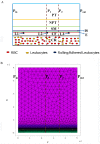Local oxidative and nitrosative stress increases in the microcirculation during leukocytes-endothelial cell interactions
- PMID: 22719984
- PMCID: PMC3375306
- DOI: 10.1371/journal.pone.0038912
Local oxidative and nitrosative stress increases in the microcirculation during leukocytes-endothelial cell interactions
Abstract
Leukocyte-endothelial cell interactions and leukocyte activation are important factors for vascular diseases including nephropathy, retinopathy and angiopathy. In addition, endothelial cell dysfunction is reported in vascular disease condition. Endothelial dysfunction is characterized by increased superoxide (O(2) (•-)) production from endothelium and reduction in NO bioavailability. Experimental studies have suggested a possible role for leukocyte-endothelial cell interaction in the vessel NO and peroxynitrite levels and their role in vascular disorders in the arterial side of microcirculation. However, anti-adhesion therapies for preventing leukocyte-endothelial cell interaction related vascular disorders showed limited success. The endothelial dysfunction related changes in vessel NO and peroxynitrite levels, leukocyte-endothelial cell interaction and leukocyte activation are not completely understood in vascular disorders. The objective of this study was to investigate the role of endothelial dysfunction extent, leukocyte-endothelial interaction, leukocyte activation and superoxide dismutase therapy on the transport and interactions of NO, O(2)(•-) and peroxynitrite in the microcirculation. We developed a biotransport model of NO, O(2)(•-) and peroxynitrite in the arteriolar microcirculation and incorporated leukocytes-endothelial cell interactions. The concentration profiles of NO, O(2)(•-) and peroxynitrite within blood vessel and leukocytes are presented at multiple levels of endothelial oxidative stress with leukocyte activation and increased superoxide dismutase accounted for in certain cases. The results showed that the maximum concentrations of NO decreased ~0.6 fold, O(2)(•-) increased ~27 fold and peroxynitrite increased ~30 fold in the endothelial and smooth muscle region in severe oxidative stress condition as compared to that of normal physiologic conditions. The results show that the onset of endothelial oxidative stress can cause an increase in O(2)(•-) and peroxynitrite concentration in the lumen. The increased O(2) (•-) and peroxynitrite can cause leukocytes priming through peroxynitrite and leukocytes activation through secondary stimuli of O(2)(•-) in bloodstream without endothelial interaction. This finding supports that leukocyte rolling/adhesion and activation are independent events.
Conflict of interest statement
Figures












Similar articles
-
Endothelial NO and O₂·⁻ production rates differentially regulate oxidative, nitroxidative, and nitrosative stress in the microcirculation.Free Radic Biol Med. 2013 Oct;63:161-74. doi: 10.1016/j.freeradbiomed.2013.04.024. Epub 2013 Apr 29. Free Radic Biol Med. 2013. PMID: 23639567 Free PMC article.
-
A computational model for free radicals transport in the microcirculation.Antioxid Redox Signal. 2006 Jul-Aug;8(7-8):1103-11. doi: 10.1089/ars.2006.8.1103. Antioxid Redox Signal. 2006. PMID: 16910758
-
The microcirculation and inflammation: modulation of leukocyte-endothelial cell adhesion.J Leukoc Biol. 1994 May;55(5):662-75. J Leukoc Biol. 1994. PMID: 8182345 Review.
-
Impact of superoxide dismutase on nitric oxide and peroxynitrite levels in the microcirculation--a computational model.Annu Int Conf IEEE Eng Med Biol Soc. 2007;2007:1022-6. doi: 10.1109/IEMBS.2007.4352468. Annu Int Conf IEEE Eng Med Biol Soc. 2007. PMID: 18002134
-
The inflammatory aspect of the microcirculation in hypertension: oxidative stress, leukocytes/endothelial interaction, apoptosis.Microcirculation. 2002;9(4):259-76. doi: 10.1038/sj.mn.7800141. Microcirculation. 2002. PMID: 12152103 Review.
Cited by
-
Microvascular Dysfunction Following Multiwalled Carbon Nanotube Exposure Is Mediated by Thrombospondin-1 Receptor CD47.Toxicol Sci. 2018 Sep 1;165(1):90-99. doi: 10.1093/toxsci/kfy120. Toxicol Sci. 2018. PMID: 29788500 Free PMC article.
-
Endothelial NO and O₂·⁻ production rates differentially regulate oxidative, nitroxidative, and nitrosative stress in the microcirculation.Free Radic Biol Med. 2013 Oct;63:161-74. doi: 10.1016/j.freeradbiomed.2013.04.024. Epub 2013 Apr 29. Free Radic Biol Med. 2013. PMID: 23639567 Free PMC article.
-
Chronic Obstructive Pulmonary Disease and the Cardiovascular System: Vascular Repair and Regeneration as a Therapeutic Target.Front Cardiovasc Med. 2021 Apr 12;8:649512. doi: 10.3389/fcvm.2021.649512. eCollection 2021. Front Cardiovasc Med. 2021. PMID: 33912600 Free PMC article. Review.
References
-
- Chow FY, Nikolic-Paterson DJ, Ozols E, Atkins RC, Tesch GH. Intercellular adhesion molecule-1 deficiency is protective against nephropathy in type 2 diabetic db/db mice. J Am Soc Nephrol. 2005;16:1711–1722. - PubMed
Publication types
MeSH terms
Grants and funding
LinkOut - more resources
Full Text Sources

